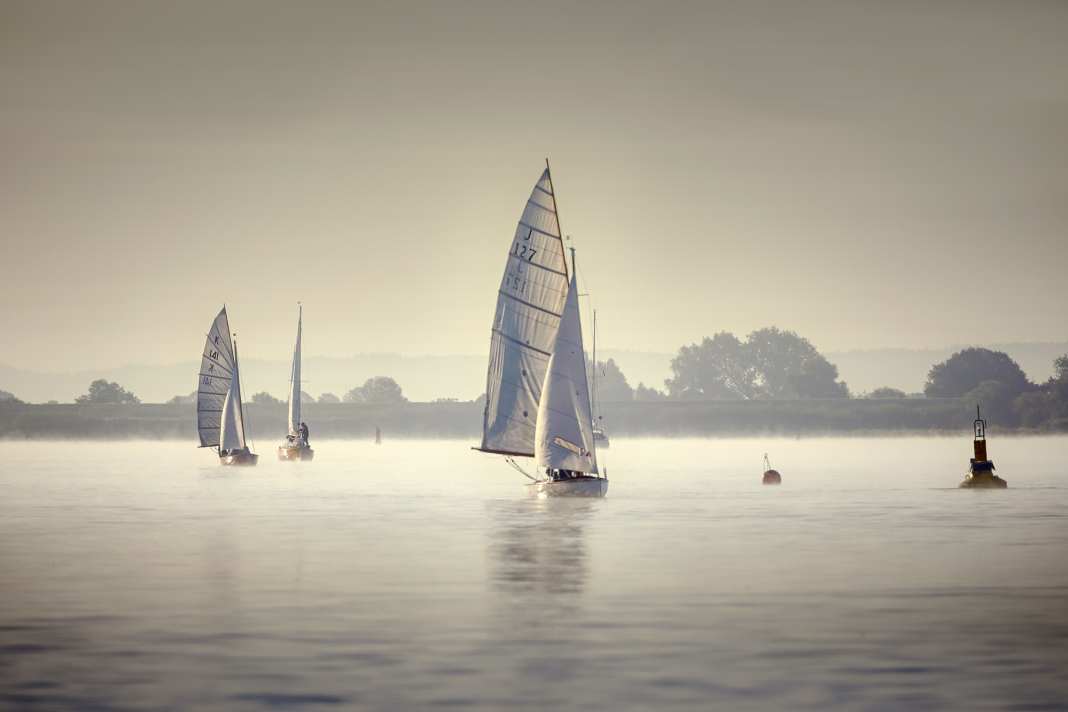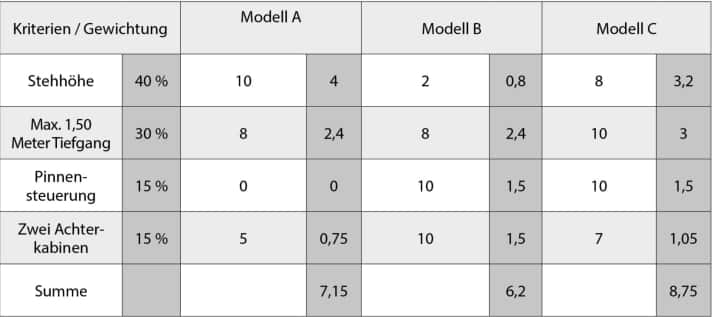Buying a used boat: Which type of boat is the right one? Decision-making aids






Finding the right used boat is a challenge. Deciding on the type of boat is the first major hurdle. The market for used boats offers hundreds of attractive options, from inexpensive small cruisers to affordable cruising yachts, and is often a better choice than buying new for cost reasons. If you have a particular dream boat in mind, such as a Hallberg-Rassy 352, a Luffe 40 or a Folkeboot, you will find that the choice of suitable boats is quickly reduced to a manageable number.
All other prospective owners are struggling with a problem. They are spoilt for choice. If you don't want your search for the right used boat to end in years of browsing through adverts, countless kilometres on the motorway, frustrating viewing appointments or even a bad purchase, it's worth investing some time in choosing the right type of boat first. As a long-standing sailor with experience on various boats, the decision in favour of or against some models may have already been made - perhaps unconsciously. But especially for beginners and anyone buying their own boat for the first time, it makes sense to proceed according to a plan.
The right plan when buying a used boat
Two aspects are essential here. Firstly, there is no such thing as the perfect second-hand boat, just as there is no such thing as the jack-of-all-trades that many people are looking for in a boat. Sitting in the deck saloon in bad weather, but still being able to flexibly change the area with the boat on the trailer, that won't work. Every boat remains a compromise.
At the same time, almost anything is possible with almost any boat and ultimately only depends on budget and personal preference: Sailing around the world on a seven-metre plastic boat works just as well as a family holiday inland on a 38-foot steel yacht. How recommendable such plans are remains to be seen.
Basically, the type of boat should match the purpose for which it is being purchased. In other words, the experience, size, usage behaviour and preferences of the crew as well as the short or long-term plans and, of course, the area. It would be unwise to buy a boat with a draught of 1.80 metres for the East Frisian Islands as a home territory. And overloading a light, fast yacht with equipment for a long voyage would ruin her once good sailing characteristics. Both are feasible, but with the right second-hand boat for your plans, you will enjoy it more.
The considerations involved in a structured boat search are somewhat reminiscent of the "W questions" that are practised in first aid courses for making an emergency call - where, who, how and so on. These are precisely the questions that are important when searching for a boat: where should you sail, how and with whom?
Find the right used boat with a click
The interactive decision tree guides you to the right type of used boat
- If you do not see the interactive tool, please click here ...
Where should be sailed?
The area of choice, usually depending on where you live, is a good first filter when looking for the right boat. Is it to be sailed inland, moored on the IJsselmeer, North Sea or Baltic coast, in the Mediterranean or even in the Caribbean? Does the crew perhaps want to take it on a long voyage?
Anyone planning a blue water voyage is usually looking for an ocean-going cruising yacht from 35 feet upwards. For the classic inland sailor, the question is rather: dinghy or cabin cruiser? If you want to sail on the Adriatic or in Greece, you will attach more importance to a yacht with a spacious cockpit and bathing platform than an owner on the North Sea coast. The latter's top priority will probably be that the ship has a draught of no more than 1.40 metres and can fall dry so that it is also suitable for sailing on the mudflats.
If you don't want to commit to a specific sailing area and would prefer to change it frequently, a trailerable boat could be the solution. Right from the start, you should consider whether your own car is suitable as a towing vehicle and - an important aspect for younger sailors - whether your driving licence allows you to tow the trailer or whether you need to take a trailer test.
How should be sailed with?
Also important: How will the boat be used? Are you planning day or weekend trips without an overnight stay on board? Then berths, toilet and galley may play a subordinate or no role at all. This is not the case with a boat that is to be used for weeks on holiday or years of cruising. However, if these comfort criteria are also desired on a small boat for inland waterways or the coast, this can simplify the choice - because it severely restricts it. Some small boat sailors without a wet room will have long since realised that a toilet on board is exactly the step that is still missing for great freedom - and consequently attach great importance to this when looking for a boat.
Experienced sailors will quickly realise whether they want to sail in a sporty manner and also race - and look for a used X-Yacht, a Dehler or Elan, for example. If the focus is on comfortable cruising and calm sea behaviour is more important than the yacht's speed potential, used yachts from Hallberg-Rassy, Najad or Contest are more likely to be of interest. If you are looking for a long-distance cruise, cruising characteristics will be less important than a protected cockpit and high stability.
How high is the budget?
A third aspect that should be realistically scrutinised at the very beginning of any boat search is the budget: what type of boat will you have enough for without having to resort to a supposed bargain with a repair backlog - and end up investing too much after all? You don't necessarily need a lot of money to make a good purchase: trailerable cabin cruisers are available from 3,000 to 5,000 euros. Smaller cruising yachts between 28 and 33 feet usually cost between 15,000 and 30,000 euros. For 35 to 40 feet there are offers between 30,000 and 50,000 euros. If it is clear that the boat will only be purchased for a certain period of time and will be sold again in the foreseeable future, this should be taken into account at the time of purchase: Well-known and popular models from series production are generally easier to resell than a one-off or an exotic series boat from a foreign manufacturer.
In financial terms, ongoing costs for mooring, winter storage, insurance and repairs should be factored in. This has an impact on the size of the boat in question - true to the motto: every metre more costs more. A trailer boat, on the other hand, can be stored privately in winter and thus save money. For a chine keeler, there is no need to purchase an extra trestle for winter storage, which also reduces costs. It is also worth considering whether your own professional or financial situation is likely to change in the foreseeable future.
As tempting as it may seem to buy as much ship as possible for as little money as possible, this plan can quickly turn out to be a fallacy. As a result, equipment is usually purchased or things repaired that would have been available or intact if a more expensive offer had been made. Which raises the next problem: How much work and associated time do you want with the new old boat? If the answer is "little" and you are not skilful enough to carry out boat work yourself, boats with wooden or steel hulls should not even be shortlisted. The decision should then be made in favour of an easy-care and generally newer GRP boat.
Priorities for buying a used boat
Once all these questions have been answered in your head or on a piece of paper, a much clearer picture of the future boat will have emerged. Perhaps it will be a cruising yacht for the North Sea and Baltic Sea of around 35 feet with a variable draught, perhaps a small class boat for family fun at weekends and regattas, perhaps a long-distance vessel with a solid hull and space for years under sail.
There are other points to consider when choosing between different types of boat that are suitable for the respective purpose. At this point at the latest, the detailed requirements of the crew, as well as their experience and size - both physically and numerically - play a role:
Are long berths and headroom a must or a cockpit designed for single-handed use? Is a teak deck or a certain hull material such as aluminium or GRP absolutely desirable or taboo? Are sea berths, tiller steering or a large refrigerator at the top of your personal list of priorities?
Simply by listing and weighting the decisive criteria, you often realise what you are actually looking for.
The type of boat has been found, but which model should it be?
An individual decision matrix allows you to set and prioritise. The bottom line: the perfect boat

Feelings when buying a used boat
At the end of all these considerations, it quickly becomes clear which type you can concentrate on. Of course, as long as the boat is in good condition, there is nothing to stop you from buying on instinct. Lines and taste still play a major role in deciding which type of boat is ultimately chosen.
Even Wilfried Erdmann, four-time circumnavigator and owner of numerous used boats, says that it is perfectly appropriate to be guided by appearance as a criterion when buying. In his book "Sailing with Wilfried Erdmann", he comments on the subject: "A boat that looks brave will not let you down." And: "A beautiful ship usually has the best sailing characteristics."
So as much as emotions and gut decisions are out of place when it comes to the actual purchase, they can still play a role when choosing the type of boat. After all, few things would be more annoying than being out on the water later with a new, second-hand boat and looking wistfully at the boats that your heart and soul would much rather have bought.
The big YACHT used boat special:
- New, used or chartered - here's what to consider
- Which type of boat is the right one? Decision-making aids
- Overview: Used boats under 6 metres
- Overview: Used boats under 7 metres
- Overview: Used boats under 8 metres
- Overview: Used boats around 9 metres
- Overview: Used boats over 9 metres
- Dream yachts: These are the favourite ships of YACHT readers
- Buying a used boat: Your guide through the online jungle
- Own inspection or surveyor? What you need to look out for
- How to avoid traps in the purchase agreement
- The boat is bought - what's next? The first steps
- What insurance do I need for my boat?

